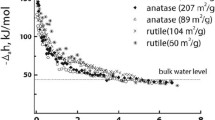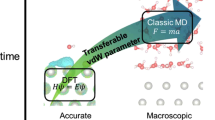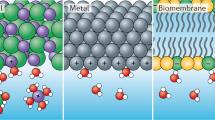Abstract
When a metal oxide surface is immersed in aqueous solution, it has the ability to bind, orient, and order interfacial water, affecting both chemical and physical interactions with the surface. Structured interfacial water thus possesses time-averaged, spatially varying polarization charge and potential that are comparable to those arising due to ion accumulation. It is well established that interfacial water structure propagates from the surface into bulk solution. Here, we show that interfacial water structure also propagates laterally, with important consequences. The constant pH molecular dynamics was used to impose a pH difference between opposite faces of a model goethite (α-FeOOH) nanoparticle and quantify water polarization charge on intervening faces. We find that the structure of water on one face is strongly affected by the structure on nearby surfaces, revealing the importance of long-range lateral hydrogen bonding networks with implications for particle aggregation, oriented attachment, and processes such as dissolution and growth.






Similar content being viewed by others
References
W.M. White: Geochemistry (Wiley, Chichester, West Sussex, UK, 2013).
J. Lyklema: Fundamentals of Interface and Colloid Science: Solid-Liquid Iterfaces (Elsevier, San Diego, 1995).
W. Stumm and J.J. Morgan: Aquatic Chemistry: Chemical Equilibria and Rates in Natural Waters (Wiley, New York, 1996).
G.E. Brown, V.E. Henrich, W.H. Casey, D.L. Clark, C. Eggleston, A. Felmy, D.W. Goodman, M. Grätzel, G. Maciel, M.I. McCarthy, K.H. Nealson, D.A. Sverjensky, M.F. Toney, and J.M. Zachara: Metal oxide surfaces and their interactions with aqueous solutions and microbial organisms. Chem. Rev. 99, 77 (1999).
G.E. Brown: How minerals react with water. Science 294, 67 (2001).
G.E. Brown and G. Calas: Mineral-aqueous solution interfaces and their impact on the environment. Geochem. Perspect. 1, 483 (2012).
L. Bousse and J.D. Meindl: Geochemical Processes at Mineral Surfaces (American Chemical Society, Washington, DC, 1987); pp. 79–98.
J.W. Bowden, S. Nagarajah, N.J. Barrow, A.M. Posner, and J.P. Quirk: Describing the adsorption of phosphate, citrate and selenite on a variable-charge mineral surface. Soil Res. 18, 49 (1980).
R. Charmas, W. Piasecki, and W. Rudzinski: Four layer complexation model for ion adsorption at electrolyte/oxide interface: Theoretical foundations. Langmuir 11, 3199 (1995).
W.H. van Riemsdijk, J.C.M. de Wit, L.K. Koopal, and G.H. Bolt: Metal ion adsorption on heterogeneous surfaces: Adsorption models. J. Colloid Interface Sci. 116, 511 (1987).
J.A. Davis, R.O. James, and J.O. Leckie: Surface ionization and complexation at the oxide/water interface: I. Computation of electrical double layer properties in simple electrolytes. J. Colloid Interface Sci. 63, 480 (1978).
D.E. Yates, S. Levine, and T.W. Healy: Site-binding model of the electrical double layer at the oxide/water interface. J. Chem. Soc., Faraday Trans. 1 70, 1807 (1974).
O. Björneholm, M.H. Hansen, A. Hodgson, L-M. Liu, D.T. Limmer, A. Michaelides, P. Pedevilla, J. Rossmeisl, H. Shen, G. Tocci, E. Tyrode, M-M. Walz, J. Werner, and H. Bluhm: Water at interfaces. Chem. Rev. 116, 7698 (2016).
J.O. Bockris and S.U.M. Khan: Surface Electrochemistry: A Molecular Level Approach (Springer, New York, 1993).
V. Raicu and Y. Feldman: Dielectric Relaxation in Biological Systems: Physical Principles, Methods, and Applications (Oxford University Press, Oxford, UK, 2015).
M.F. Toney, J.N. Howard, J. Richer, G.L. Borges, J.G. Gordon, O.R. Melroy, D.G. Wiesler, D. Yee, and L.B. Sorensen: Voltage-dependent ordering of water molecules at an electrode—electrolyte interface. Nature 368, 444 (1994).
Y.R. Shen and V. Ostroverkhov: Sum-frequency vibrational spectroscopy on water interfaces: Polar orientation of water molecules at interfaces. Chem. Rev. 106, 1140 (2006).
M.A. Henderson: The interaction of water with solid surfaces: Fundamental aspects revisited. Surf. Sci. Rep. 46, 1 (2002).
J. Carrasco, A. Hodgson, and A. Michaelides: A molecular perspective of water at metal interfaces. Nat. Mater. 11, 667 (2012).
P. Fenter and N.C. Sturchio: Mineral—water interfacial structures revealed by synchrotron X-ray scattering. Prog. Surf. Sci. 77, 171 (2004).
J.N. Israelachvili and R.M. Pashley: Molecular layering of water at surfaces and origin of repulsive hydration forces. Nature 306, 249 (1983).
E. Spohr: Molecular simulation of the electrochemical double layer. Electrochim. Acta 44, 1697 (1999).
A. Wieckowski: Interfacial Electrochemistry: Theory: Experiment, and Applications (CRC Press, New York, 1999).
J. Wang, A.G. Kalinichev, and R.J. Kirkpatrick: Effects of substrate structure and composition on the structure, dynamics, and energetics of water at mineral surfaces: A molecular dynamics modeling study. Geochim. Cosmochim. Acta 70, 562 (2006).
S.H. Lee and P.J. Rossky: A comparison of the structure and dynamics of liquid water at hydrophobic and hydrophilic surfaces—A molecular dynamics simulation study. J. Chem. Phys. 100, 3334 (1994).
M.R. Philpott and J.N. Glosli: Electric potential near a charged metal surface in contact with aqueous electrolyte. J. Electroanal. Chem. 409, 65 (1996).
P. Zarzycki, S. Kerisit, and K.M. Rosso: Molecular dynamics study of the electrical double layer at silver chloride- electrolyte interfaces. J. Phys. Chem. C 114, 8905 (2010).
P. Zarzycki and K.M. Rosso: Molecular dynamics simulation of the AgCl/electrolyte interfacial capacity. J. Phys. Chem. C 114, 10019 (2010).
P. Zarzycki, S. Kerisit, and K.M. Rosso: Molecular dynamics study of Fe(II) adsorption, electron exchange, and mobility at goethite (α-FeOOH) surfaces. J. Phys. Chem. C 119, 3111 (2015).
P. Zarzycki and K.M. Rosso: Surface charge effects on Fe(II) sorption and oxidation at (110) goethite surfaces. J. Phys. Chem. C 122, 10059 (2018).
J. Mongan, D.A. Case, and J.A. McCammon: Constant pH molecular dynamics in generalized born implicit solvent. J. Comput. Chem. 25, 2038 (2004).
P. Zarzycki, D.M. Smith, and K.M. Rosso: Proton dynamics on goethite nanoparticles and coupling to electron transport. J. Chem. Theory Comput. 11, 1715 (2015).
M. Borkovec: Origin of 1-pK and 2-pK models for ionizable water—solid interfaces. Langmuir 13, 2608 (1997).
M. Borkovec, J. Daicic, and G.J.M. Koper: Ionization properties of interfaces and linear polyelectrolytes: A discrete charge Ising model. Phys. A 298, 1 (2001).
J.R. Rustad, E. Wasserman, A.R. Felmy, and C. Wilke: Molecular dynamics study of proton binding to silica surfaces. J. Colloid Interface Sci. 198, 119 (1998).
P. Zarzycki: Computational study of proton binding at the rutile/electrolyte solution interface. J. Phys. Chem. C 111, 7692 (2007).
P. Zarzycki: Comparison of the Monte Carlo estimation of surface electrostatic potential at the hematite (0001)/electrolyte interface with the experiment. Appl. Surf. Sci. 253, 7604 (2007).
P. Zarzycki and K.M. Rosso: Nonlinear response of the surface electrostatic potential formed at metal oxide/electrolyte interfaces. A Monte Carlo simulation study. J. Colloid Interface Sci. 341, 143 (2010).
P. Zarzycki, S. Chatman, T. Preočanin, and K.M. Rosso: Electrostatic potential of specific mineral faces. Langmuir 27, 7986 (2011).
J.R. Rustad and A.R. Felmy: The influence of edge sites on the development of surface charge on goethite nanoparticles: A molecular dynamics investigation. Geochim. Cosmochim. Acta 69, 1405 (2005).
P. Zarzycki: Monte Carlo simulation of the electrical differential capacitance of a double electrical layer formed at the heterogeneous metal oxide/electrolyte interface. J. Colloid Interface Sci. 297, 204 (2006).
P. Zarzycki: Monte Carlo modeling of ion adsorption at the energetically heterogeneous metal oxide/electrolyte interface: Micro- and macroscopic correlations between adsorption energies. J. Colloid Interface Sci. 306, 328 (2007).
P. Zarzycki: Monte Carlo study of the topographic effects on the proton binding at the energetically heterogeneous metal oxide/electrolyte interface. Langmuir 22, 11234 (2006).
P. Zarzycki, R. Charmas, and P. Szabelski: Study of proton adsorption at heterogeneous oxide/electrolyte interface. Prediction of the surface potential using Monte Carlo simulations and 1-pK approach. J. Comput. Chem. 25, 704 (2004).
P. Szabelski, P. Zarzycki, and R. Charmas: A Monte Carlo study of proton adsorption at the heterogeneous oxide/electrolyte interface. Langmuir 20, 997 (2004).
D. Frenkel and B. Smit: Understanding Molecular Simulations: From Algorithms to Applications (Academic Press, San Diego, 2002).
W.C. Swope, H.C. Andersen, P.H. Berens, and K.R. Wilson: A computer simulation method for the calculation of equilibrium constants for the formation of physical clusters of molecules: Application to small water clusters. J. Chem. Phys. 76, 637 (1982).
H.C. Andersen: Rattle: A “velocity” version of the shake algorithm for molecular dynamics calculations. J. Comput. Phys. 52, 24 (1983).
R.M. Handler, A.J. Frierdich, C.M. Johnson, K.M. Rosso, B.L. Beard, C. Wang, D.E. Latta, A. Neumann, T. Pasakarnis, W.A.P.J. Premaratne, and M.M. Scherer: Fe(II)-catalyzed recrystallization of goethite revisited. Environ. Sci. Technol. 48, 11302 (2014).
P. Venema, T. Hiemstra, P.G. Weidler, and W.H. van Riemsdijk: Intrinsic proton affinity of reactive surface groups of metal (Hydr)oxides: Application to iron (Hydr)oxides. J. Colloid Interface Sci. 198, 282 (1998).
D.W. Walker and J.J. Dongarra: MPI: A standard message passing interface. Supercomputer 12, 56 (1996).
W. Gropp, E. Lusk, N. Doss, and A. Skjellum: A high-performance, portable implementation of the MPI message passing interface standard. Parallel Comput. 22, 789 (1996).
D. Spagnoli, B. Gilbert, G.A. Waychunas, and J.F. Banfield: Prediction of the effects of size and morphology on the structure of water around hematite nanoparticles. Geochim. Cosmochim. Acta 73, 4023 (2009).
J.J. De Yoreo, U.P. Pupa, A.J. Nico, R. Lee Penn, S. Whitelam, D. Joester, H. Zhang, J.D. Rimer, A. Navrotsky, J.F. Banfield, A.F. Wallace, F. Marc Michel, F.C. Meldrum, H. Cölfen, and P.M. Dove: Crystallization by particle attachment in synthetic, biogenic, and geologic environments. Science 349, aaa6760 (2015).
X. Zhang, Y. He, M.L. Sushko, J. Liu, L. Luo, J.J. De Yoreo, S.X. Mao, C. Wang, and K.M. Rosso: Direction-specific van der Waals attraction between rutile TiO2 nanocrystals. Science 356, 434 (2017).
X. Zhang, Z. Shen, J. Liu, S.N. Kerisit, M.E. Bowden, M.L. Sushko, J.J. De Yoreo, and K.M. Rosso: Direction-specific interaction forces underlying zinc oxide crystal growth by oriented attachment. Nat. Commun. 8, 835 (2017).
Y. Liu, Y. Zhang, G. Wu, and J. Hu: Coexistence of liquid and solid phases of Bmim-PF6 ionic liquid on mica surfaces at room temperature. J. Am. Chem. Soc. 128, 7456 (2006).
L. Tamam, B.M. Ocko, H. Reichert, and M. Deutsch: Checkerboard self-patterning of an ionic liquid film on mercury. Phys. Rev. Lett. 106, 197801 (2011).
C. Merlet, D.T. Limmer, M. Salanne, R. van Roij, P.A. Madden, D. Chandler, and B. Rotenberg: The electric double layer has a life of its own. J. Phys. Chem. C 118, 18291 (2014).
A.A. Kornyshev and R. Qiao: Three-dimensional double layers. J. Phys. Chem. C 118, 18285 (2014).
M. Valtiner, X. Banquy, K. Kristiansen, G.W. Greene, and J.N. Israelachvili: The electrochemical surface forces apparatus: The effect of surface roughness, electrostatic surface potentials, and anodic oxide growth on interaction forces, and friction between dissimilar surfaces in aqueous solutions. Langmuir 28, 13080 (2012).
A. Voukadinova, M. Valiskó, and D. Gillespie: Assessing the accuracy of three classical density functional theories of the electrical double layer. Phys. Rev. E 98, 012116 (2018).
F. Jiménez-Ángeles and M. Lozada-Cassou: A model macroion solution next to a charged wall: Overcharging, charge reversal, and charge inversion by macroions. J. Phys. Chem. B 108, 7286 (2004).
J. Forsman: A simple correlation-corrected Poisson−Boltzmann theory. J. Phys. Chem. B 108, 9236 (2004).
M.L. Sushko and K.M. Rosso: The origin of facet selectivity and alignment in anatase TiO2 nanoparticles in electrolyte solutions: Implications for oriented attachment in metal oxides. Nanoscale 8, 19714 (2016).
Z. Shen, J. Chun, K.M. Rosso, and C.J. Mundy: Surface chemistry affects the efficacy of the hydration force between two ZnO\(\left( {10\bar 1\bar 0} \right)\). J. Phys. Chem. C 122, 12259 (2018).
S.V. Yanina and K.M. Rosso: Linked reactivity at mineral-water interfaces through bulk crystal conduction. Science 320, 218 (2008).
ACKNOWLEDGMENTS
This material is based on work supported by the U.S. Department of Energy, Office of Science, Office of Basic Energy Sciences, Chemical Sciences, Geosciences, and Biosciences Division, through its Geosciences programs at LBNL (under Contract DE-AC02-05CH11231) and PNNL.
Author information
Authors and Affiliations
Corresponding author
Additional information
This author was an editor of this journal during the review and decision stage. For the JMR policy on review and publication of manuscripts authored by editors, please refer to http://www.mrs.org/editor-manuscripts/.
Rights and permissions
About this article
Cite this article
Zarzycki, P., Colla, C.A., Gilbert, B. et al. Lateral water structure connects metal oxide nanoparticle faces. Journal of Materials Research 34, 456–464 (2019). https://doi.org/10.1557/jmr.2018.478
Received:
Accepted:
Published:
Issue Date:
DOI: https://doi.org/10.1557/jmr.2018.478




